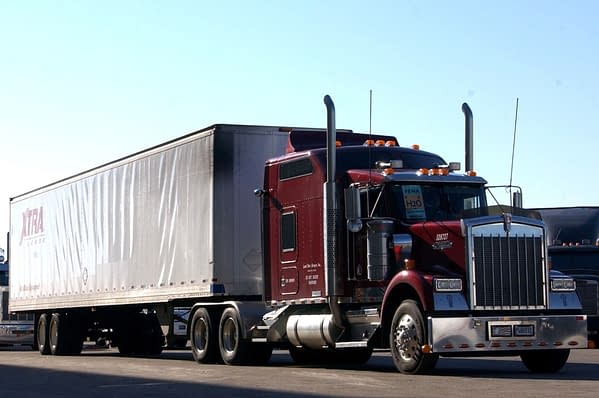Posted in: Comics, Current News | Tagged: Comics, delays, distribution, shipping
Increased Driver Wages & Customs Congestion Affect Comics Distribution
Bleeding Cool has been reporting major delays and stock issues hitting the comics industry, including information from Bad Idea, DC Comics, and from Marvel Comics, while there is still a "manga drought". Yesterday, we ran an internal industry report from a major printer looking at printing issues for comics and other printed materials. But they also wanted to emphasise shipping issues as well, both inside the USA and globally. Many American comics publishers print books, especially high-end books, in East Asia, as well as using domestic or Canadian printers. But getting comics out there in any fashion is becoming an increasing problem Here's the view from one printer and distributor.

Ocean Freight: The ocean freight market continues to be plague by heavy port congestion, space availability, reduced port capacity due to COVID related illnesses, and container shortages and high shipping rates. Global Port Congestion worsened as ripple effects of the shutdown of Ningbo and Yantian ports due to Covid-19 cases trickled down the global supply chain. Almost all ports in the US are experiencing heavy congestion. The delayed vessels from Asia further prolong the discharges of vessels. Rail operators continue to reduce the capacity to move containers from port to inland destinations as in-land destinations becomes clogged with containers given chassis and truck capacity remain tight overall. The toughest shortages are presently seen in the Midwest and Southeast areas. This high market volatility is expected to last through the balance of this year and into second quarter 2022. Shipping rates continue to increase as shippers are desperate for any available space fueling a fierce price competition. Steamship lines continue to ship the minimal amount of contractual and base level cargo as possible, leaving as many slots as possible to sell on the spot market causing "premium" rates to continue go up.
Domestic US Freight: Many of the drivers who left the industry at the pandemic's onset have yet to return. Low driver school enrollments due to COVID protocols and some 85,000 operators with failed drug tests (according to Drug & Alcohol Clearinghouse data) are just some of the obstacles the fleets face. As a result, carriers are having to raise driver pay to retain them, and we are seeing those increased wages reflected in their contract and spot pricing. A Department of Commerce advisory group is urging federal officials to lead a widespread effort to address the nationwide shortage of truck drivers, which the panel said has "likely reached an all-time high." The American Trucking Associations has estimated the industry is short at least 60,000 drivers. The outlook for demand remains extremely strong. There has been record freight volumes for months, and there is no immediate end in sight. There is a large amount of freight already in the US, sitting in warehouses or rail yards waiting to be moved to their destination. It is estimated Union Pacific has 25 miles worth of trains and BNSF has 22 miles of trains, all sitting outside the Joliet, IL rail facility. It is going to take time to work through all these backlogs, especially with peak retail season on the way. Capacity remains very tight, and pricing continues to rise. Moreover, August through November is the typical peak season for the Christmas/holiday cargo further stressing the supply chain. During this time, expect carriers to apply their Peak Season Surcharges ("PSS") further driving prices upward. Pre-planning is critical to ensure capacity and competitive pricing. Please reach to TradeRunner for assistance in planning critical shipments.
Branded Merchadise: Ocean freight is the biggest pain point for branded merchandise coming from overseas. A large majority of the items we source in this category of spend come from factories in Asia because of the high quality and competitive pricing. However, due to the volatility of ocean freight capacity and pricing, we are seeing a 40% to 50% increase in price due to the limited availability of containers and corresponding higher shipping rates. We are also experiencing longer transit times due to the reduced capacity and port congestion. Other factors are affecting branded merch items coming from Asia. The U.S. dollar's value against the Chinese yuan has also declined, dropping roughly 7.5% from a year ago, causing prices to further increase anywhere from 5% to 10%. Rising raw material costs – including cotton, steel, gas and oil (affecting polyester and plastic), polyethylene, polypropylene and other chemical compounds – are also fueling these price increases. The Meidong Container Terminal at the Port of Ningbo-Zhoushan in Zhejiang Province closure due to COVID-19 related concerns is causing a backlog of vessels at the port. From this closure, reports indicate that increased congestion is occurring at nearby ports, include the Port of Shanghai, due to ship diversions. Inventory shortages are yet another headwind in the branded merchandise space. Earlier this year, a few suppliers were faced with supply chain challenges that led to their inventory declining to significantly lower-than-historical levels. While demand across almost all of product categories has remained strong and some of our suppliers' inventory has held steady for the last few months, they have not been able to grow inventory levels as much as they would have liked. As COVID‑19 infection rates continue to change around the world, production has been impacted in different countries at different times. Today, shutdowns in Vietnam and Indonesia are especially concerning, and some of our suppliers are also now facing a shortage of yarn as many U.S. yarn vendors are not operating at full capacity due to labor shortages. With the pricing challenges outlined above, be certain to examine full delivered costs when sourcing product, including delivery schedules.
What Can We Do? The best path through these unprecedented supply chain challenges for paper, substrates, ocean freight and branded merch is communication of the supply chain challenges, planning requirements well in advance, committingto projectsearly and remaining flexible.
Freight: While it will be impossible not to be affected by the market problems (whether by congestion, lack of space or high shipping rates), there are a few options to reduce potential impacts to supply chains. As with paper/substrates, plan ahead . . . and as far in advance as possible. By providing visibility of expected shipments 4 – 6 weeks out, it allows us the opportunity to pre-book space and secure it when becomes available. When faced with a short lead time situation, we will identify critical quantities that can be expedited via air freight, though prepare for sticker price shock given air cargo has also limited space as demand is at all time high due to the disruption on traditional lanes. Anticipate and be prepared for additional charges and potentially dramatic rate increases – this could be anything from trucking fees at origin, ocean freight premiums and/or extra costs domestically for wait time or chassis.
Branded Merchandise: To help mitigate some of the challenges procuring branded merch in Asia is currently experiencing, our strategic sourcing is looking into other countries where ocean freight may be less expensive such as EMEA or LATAM Shipments from EMEA would enter the US through the east coast ports, which are slightly less congested than the west coast, potentially decreasing lead time. We are looking into sourcing some branded merchandise items in Mexico, where product could be shipped via truckloads. Additionally, we are making contingency plans for other countries to be flexible should disruptions start causing production issues. As is the case with paper, substrates, and ocean freight, planning ahead and communication is critical. Is there an opportunity to move up order windows by 4 to 6 weeks to help offset the longer transit times? If you can't move up the order windows, can we get pre-commitments of overseas items based on historical order information for the most critical requirements. Is there a possibility to air freight an initial quantity of those critical items, allowing the balance to ship ocean freight? While more costly, it would ensure the order is delivered on time.
Plan early for your holiday needs. Stock orders will need to be placed as soon as possible to ensure inventory is available and can be completed on-time.
Any information that comics readers have to share with Bleeding Cool, we would be most grateful for, and anonymity will be assured.











